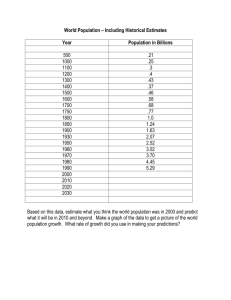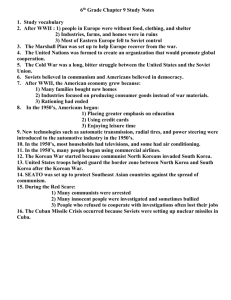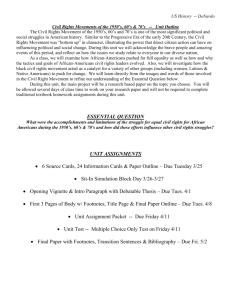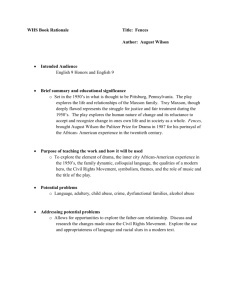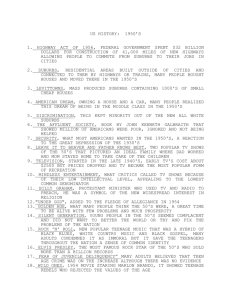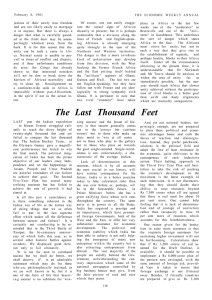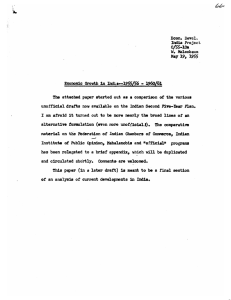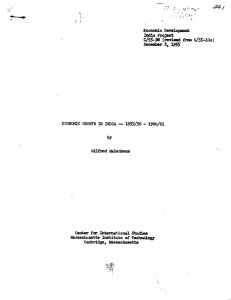India Lna Io.Dsv. Aoi the
advertisement
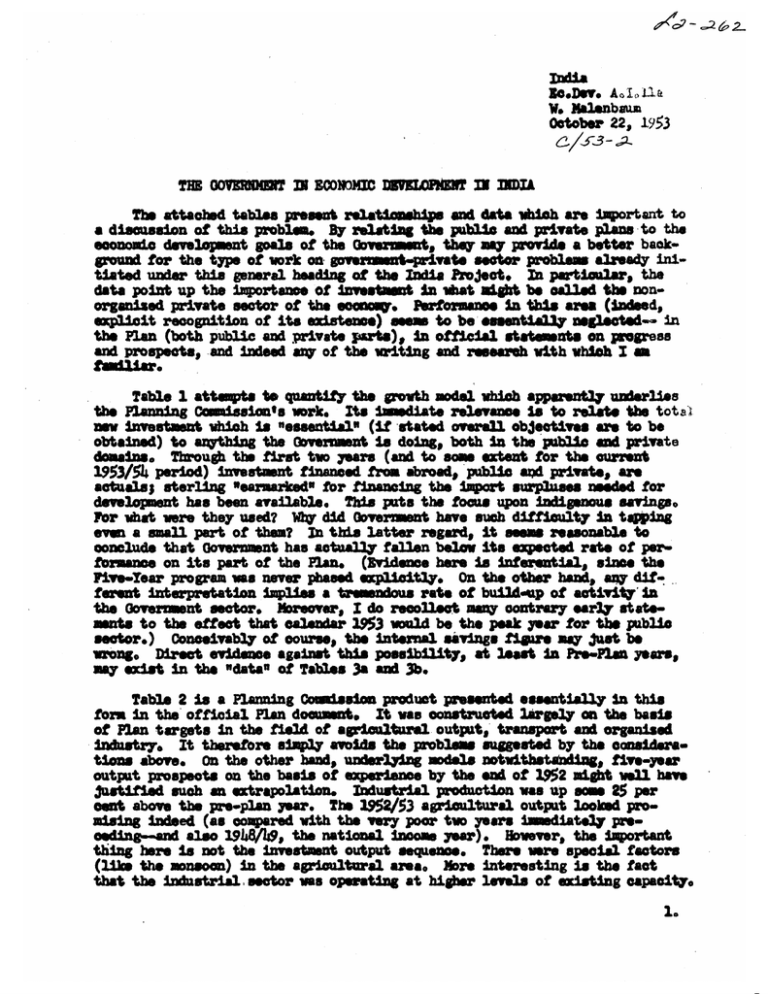
India Io.Dsv. Aoi 0Lna W. Malenbum October 22, 1953 THE 00RETN 0MODI DgmM WM INDMI The attached tables presenk relatioiships and data which are important to a discussion of this problem. By relating the public and private pans to the they Wovrnnt, may provide a better backeconomic development goals of the ground for the type of work on governmsnt-wivate sector problems already initieted under this general heading of the India Project. In particular, the data point up the importance of investt in what might be alled the nonorganised private sector of the econ . Nrformanoe in this area (indeed, explcit recognition of its existence) seems to be essentially neglected-- in the Plan (both public and private parts), in official statemenUs on pogreas and prospects, and indeed any of the writing and research with which I aM familar. Table 1 attempts to quantity the growth model which apparent3 underlies the Planning Com4s ntos work. Its inmediate relevance is to relate the total nDy investment which Is "essential" (if stated overall objectives are to be obtained) to anything te Government is doing, both in the public and private domains. Through the first two years (and to some extent for the current 1953/54 period) investment financed from abroad, public and private, are actual.; sterling xearmarked" for financing the import surpluases needed for development has been available. This puts the focus upon indigenous savings. For what were they used? M1y did Government have such difficulty in tapping even a small part of then? In this latter regard, it seems reasonable to oonclude that Government has actually fallen belaw its expected rate of per-. formance on its part of the Plan. (ividence here is inferential, since the Five-lear program was never phased explicity. On the other hand, any dif-! ferent interpretation implies a tre-ndous rate of buid-up of activity' in the Government sector. Moreover, I do recolle4 many contrary early statements to the effect that calendar- 1953 would be the peak year for the public sector.) Conceivably of oourse, the internal savings figure may just be wong. Direct evidence against this possibility, at least in Pre-Plan years, may exist in the "data" of Tables 3a and 3bp Table 2 is a Planning noadsicn product presented essentially in this form in the official Plan docuaent. It was constructed largely an the basis of Plan targets in the field of agricultrial output, transport and organised industry. It therefore simply avoids the probleas suggested by the considerstions above. On the other hand, underlying models notwithstanding, five-year output prospects on the basis of experience by the end of 1952 might well have justified such an extrapolation. Industrial production was up some 25 per cent above the pre-plan year. The 3952/53 agricultural output looked promising indeed (as compared with the very poor two years immediately preoeding--and also 1948/19, the national income year). However, the important thing here is not the investment output sequence. There were special factors (lik the monsoon) in the agricultural area. More interesting is the fact that the industrial sector was operating at higher levels of existing capacity. L THE FIVE YEAR PLAN DEVELOPENIT IDEL* (Rs. or., 1950/51 prices) Natl, Cos Ition** M6ioial' Inr..Rieal Savings Loans and grants "D90TiciRUTotal"M~ Piate Iv lor.Inv. Financing" - 5151 9>00 8550 450 (3) (4) (5) 53/52 9350 8670 4O 62 - 52/ 9330 88Mh 5%6 45 12 5?/54 9520 8966 554 60 15 75 704 A/55 9755 9154 601 76 30 85 792 55/56 10020 9366 65 76 45 200 875 2805 319 102 260 3486 () (2) 5 Tr.Plan Period (6) ) -511 573 This "period analysis" is based almost entirely upon GOI plans and statemants, although the total picture has never been presented, at least to mV knowledge. * There is, on the other hand, god oormboration for the 1955/56 national in. com estimate,of the domestic savings over the 5-year period, and soamwhat generally of the fther assistance. * In tis investment that could be made through deficit financing and foreign model, per capita onsuqpion will increase by 3% over the plan period, from 234 re. to 2a. -ial (1) growth of 1/ This assumes a population of 365 miion in 1950/51, and an per cent to 388.5 1950/51, an official aproxUmation. 14on for 1955/56. Subsequent totals are derived through a cpital income ratio of 3.0. (2) Col (1) mims ol (3). (3) 1950/51, average propensity to conmm of .95. ginal propensity is taken at .80. (4) The 1951/52 and 1952/53 figures are the actual use of foreign assistance as given by the Reserve Bank. The subsequent figures have been allocated on the basis of the foreign total assistance. already provided (51-53 b the IBan, U.s. and 109 orores Colombo Plan countries). from U.S. for IT '54 0 20 from other Colombo Plan countries, F '514 20 40 3V(5) (6) . For the remaining years the mar. IsID (new steel mil) other Colombo Plan countries'54-56. Total Dnay 52/53 figure is reasonably accurate (largely oil refineries), Subsequent years are estimated, but coincide with the Planning rmisslones total foreign private investment for the 5-year period. Estimated on the assump*on that the 001 will draw down sterling balances as they have Indiated for the 5-yr. period taken together.There has been essentialy no drawing down to date. 2. he statistical epItsl income ratio for inastr was undoubted3y ew-car- tainly by oc-parison with the lvel it has in the overall ratio of 3:1 used in the model. (I mast admit that It is this point which counts for the inolusion of Table 2. Perhaps--wto take a long jgAthe on3 model for Indian development which meets the objectivess especialy in the shor6t-nai, of the Min such favorable output responses.) Gomvrnmnt is one which exploits to the To return, however, it does seem tre that not capital formation in 1950/51 was of the order of 5 per cena of national income. (Table 3a) on the savings side (3b) the picture is undoubtedly stretched, since the money flows for which there is direct evidence seessa to cover only the orgadsed investment (Government and most of industry-perhaps some 250 oreres out of the total). O0 this showing alone, there might be real doubts about te 'accepted' savings ratio. On the other hand, e etheAejee and Mhsh did cstruct, largely on the bitsi of product flows, an estimate of about 400 crores of real investment (net) in of a -co-ndities 195/51* Basic elements in their coqputaticn eMre imported _o-based ontrz products, sinilar of output capital ood natre, domestic on steel and concrete statistics, village surway material on irrigatimon, bands, and of course, governt records. Of interest too is the fact that to method suggested the need to expand their estimate of monstised -investment by an additional amount for "rural construction" whose gross value they lapute at 165 crores, 90 net. This capital formation refacts use of underemqploed resources; it is not of course enopassed in national product accounts. Ohe investment 90 crores adds about 50 per cent to their estimate of (oneAtised) the private to cent per 80 about in the private sector. And of course, It adds capital wbere areas suggests investment of a non-organised nature. (This again Income ratios are low.) Sinoe 1950/1 was not obviously :atypical M- with respect to investment, it can be presamed that it conttimes at some rate through the Plan years. Such uArganised investment must fill most of the gap between the Plans (public and private) and savings in India. The bulk of It apparently pea into housing construction. I don't know whether this deserves the pr'iority claim It see resources in India. I would tink this should onsum to exercise upon n be a private investment problta of major oonsern to the Governments. Efforts are needed to channel more of these savings through organised investment outlets-perhaps by expanding thi Plans or at least by frlfillang the stated pals. Suppleasantary (or alternaive) efforts are needed toward infinencing investment patterns in areas where money savings oanat be tapped and where non-monetary investment oould be of a signifioant mpiAnde. Both subjects require inestigation. Tables 5 and 6 are starting points for discussing the proble of increasing he flew of India's investible resources through aovernmnt (or organised business). Nors data will be forthconsag. As they take form, I suspect that they will point up the stikMneSS of the non-zonetised (largely te small enterprise) sotor of the Indian The disussioz willM as naturally merge into the second subject, eoono. a pattern of development in Inda which, at least for a short period, focusses more directay upon the vast urderdeveloped parts of the country. NW NATIONAL UTPUT (48/49 prices, as. 1200 o.) 1950/51* 1948/49 1955/56 LMI(x or 9)(A Primarily A. ousehold 1. agrio. (amel. plantations) 10. 2. fishery O.2 4. professions, arts 3.2 151 3. sman enterprises 5. domestis service 47. 0.3 10.6 9.4 3.4 (62.2) sub-total 6. or 9 14rT. (62.5) B.' Larger Enterprises 7. aWiS. (plantations) 8. forestry 9. 30. 1. 12. 0.9 0.7 o.6 mlning factory establishbmnt railways o.6 oao.miniation organised banking, ins. 0.3 0.6 0.8 6.8 2.3 5.0 1.8 o.A o.6 iiir (10.9) sub-total (12.3) C. Others 25. other ooumwce and transporb 4.6 17. house property 18. (26.9) sub-total 3. Nt. Dam. Prodnct 20. Net foreign 4nom s 21. Net National Output * 25.4 5.1 48 .14.4 16. gov't services (admin.) (300.0 ( 10. 87.1 2 (25. (200.1 "o.0.2) 100,0 on the assumption that per copita produact was unchanged from 1948/49. Perhaps all umb-categories of (19) can also be treated in this way. Such use has been nade by Planning Conmsian and by statisticians of the National Income Unit. 4 * la ks I X 14.8 lag. m 1119 a ~I FtjI,;. 1 I iihhIjj w0 Irmw go..' -'J!Ut I I I I j FE b (Ns. 015. 1950/1 Prises) Pla das) (ata) 2a3 -erod (q* 5 rpus unemomes 0*#105,Operation(e2m) IPrivatSan Zmmwrnes afan SUVIn5S PARviMt fand 8t-st n smal transpoet DIret Savetint balnes Item a. con- -3b 21i0 30 a60 35 Share .qpitaI of co earetIsos Dseosits in schedulmd banks Direst is-aw6 - a0 25 40 h7, - mporate (F1k67) 22 SPublic savings are derived from the Plan. Total private savings are a resShawl with unbreackted figues those for which some direct evidanoe is suggestive. i. 2. aeorded surpbia on current account QCOrded as 122 oes. Howver, the Actu13 onsals a. oc3leotion of items agpegatig 47 orres. Thins represmnt ezpsuiturs of a rewureu nature and bonee sumt 1 matched against the not capital fozuatSan Prom this total the Governmnt borowed some 77 crores in 1950/51. m~le there was obtained soms 42 crore a doorease of 3 ororse in the funded debt, the (oernnt fire the sall savings scheme and from the state provident funds. It obtained 38 ame crores fran dposits. wo.s actua137 estimated at 568 crores for S-ear plan purposes. ever, expenditures of a non-moaptal Oo wtian nature which are Included In the Plan agggate about I00 craes over the 5-year period, 3. This Urplus . According to the lan, the Gover nt antisipates borroing about 520 craves frpm this -total. (US roes through increase In the funded debt, 270 crores from vardsus types of ann savings and 235 otores from various deposits.) zn the first two years, odT samal aavings have amr or less oorresponded with this estimate. There was actua33y a nt deaease In other B Im of peramnt Indebtedness. Total borrcwings for the two years thus netted onay 27 oa*es. .4 Tabu 5 0 a aim; IlS I &1iI U jlEl lIN I ii:"l ii' I lb A4 S 041 E4~ '40 I. W) I I I I 'II'" - 35 - TABLE 6 India: Percentage Distribution of the Major Heads of Tax Receipts in Consolidated Accounts of the Central Government and the Govenments of Class A States* n 1928/29 1933/34 1938/39 1941/42 19h6/47 1948/49 1949/50 1950/51 1951/52 1952/53 Heads of Revenue VUs toms duties Income and Corporation tax Excise and sales tax Stamp and registration duties Others 32 Total tax revenue excluding land tax Land Revenue Total consolidated tax revenue e 1w 34 33 23 20 24 23 26 3 28 30 26 26 26 -4 9 11 12 12 25 35 20 9 6 18 9 5 23 7 6 22 6 8 23 4 11 23 3 8 25 4 12 25 4 9 2L 3 8 ?U 78 81 o4 93 95 95 94 >5 93 22 22 19 16 7 5 5 6 5 ? 100 100 100 100 100 100 100 100 100 100 37 31 Figures up to 1946/7 (inclusive) are those of former provinces of Cindivided Indias from 1946-49 they are of Class A Sjates of India, namely, Assam, Bihar, Bombay, East Punjab, Madhya Pradesh, Madras, Orissa, Uttar Pradesh, and West Bengal, Sourcet Absolute data compiled from India's Statistical Abstract, Budget Documents, and Reserve Bank of india'1 Rprt on CurrencZ and Finance. Fiscal Division, nted Taken frons The Operation of the Land Tax in India and Pakistan," Nations (New York, Mays1953) -,," I-I----
